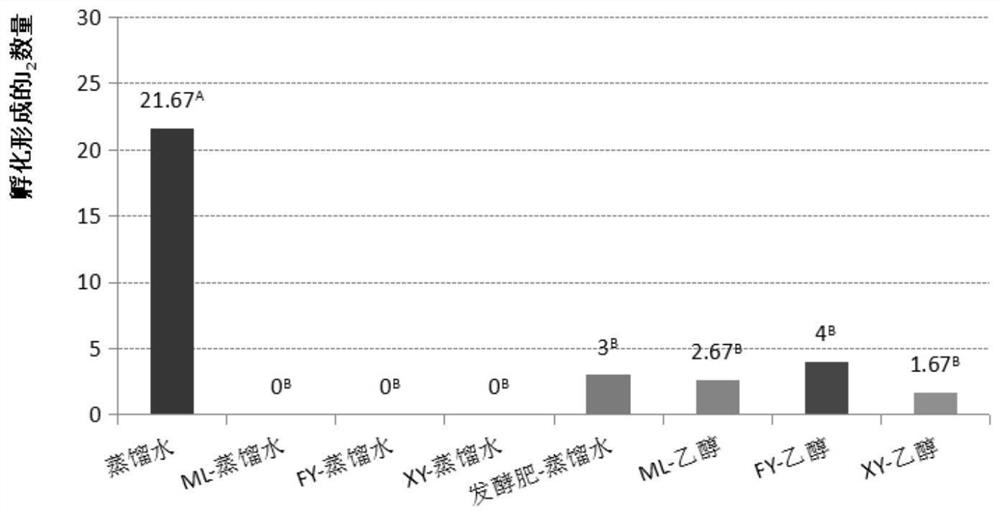A method for improving the efficiency of root-knot nematode resistance of oily radish
A technology against root-knot nematodes and oil radish, applied in nematicides, botanical equipment and methods, chemicals for biological control, etc., can solve the problem of ineffective anti-root-knot nematodes and toxicity to humans and ecological hazards , the active ingredients of oily radish are not high, and achieve the effects of diverse transmission routes, wide host range, and increased porosity
- Summary
- Abstract
- Description
- Claims
- Application Information
AI Technical Summary
Problems solved by technology
Method used
Image
Examples
Embodiment 1
[0020] A method for improving the anti-root-knot nematode efficiency of oily radish, specifically comprising the following steps:
[0021] (1) Preparation of oily radish straw powder: pick the oily radish stems and leaves after the oily radish is mature, dry the oily radish stems in an oven at 65°C for 20 hours until the water content is 13%, then crush them with a pulverizer and pass through 200 mesh Sieve the resulting powder for later use.
[0022] (2) The oily radish straw powder was added into distilled water at a ratio of 100 g / L, soaked for 45 hours, centrifuged at 12000 rpm for 10 minutes, and the supernatant was collected.
[0023] (3) Concentrate the supernatant of step (2) until the solid content accounts for 55% to obtain the initial extract; add fulvic acid to the initial extract at a ratio of 120g / L to obtain the final root-knot nematode inhibitor .
Embodiment 2
[0025] A method for improving the anti-root-knot nematode efficiency of oily radish, specifically comprising the following steps:
[0026] (1) Preparation of oily radish straw powder: pick the oily radish stems and leaves after the oily radish is mature, dry the oily radish stems and leaves under natural conditions for 15%, then crush them with a pulverizer and pass through a 150-mesh sieve, and the resulting powder is ready for use .
[0027] (2) The oily radish straw powder was added into distilled water at a ratio of 110 g / L, soaked for 55 hours, centrifuged at 12000 rpm for 10 minutes, and the supernatant was collected.
[0028] (3) Concentrating the supernatant of step (2) until the solid content accounts for 60% to obtain the initial extract; adding fulvic acid to the initial extract at a ratio of 110g / L to obtain the final root-knot nematode inhibitor .
Embodiment 3
[0030] A method for improving the anti-root-knot nematode efficiency of oily radish, specifically comprising the following steps:
[0031] (1) Preparation of oily radish straw powder: pick the oily radish stems and leaves after the oily radish is mature, dry the oily radish stems and leaves under natural conditions until the water content is 12%, then crush them with a pulverizer and pass through a 300-mesh sieve , and the resulting powder is ready for use.
[0032] (2) Add oily radish straw powder into distilled water at a ratio of 90 g / L, soak for 50 h, centrifuge at 12000 rpm for 10 min, and collect the supernatant.
[0033] (3) Concentrating the supernatant of step (2) to a solid content ratio of 56% to obtain the initial extract; adding fulvic acid to the initial extract at a ratio of 100g / L to obtain the final root-knot nematode inhibitor .
[0034] Get the extract in Examples 1 to 3 of the present invention, and study its inhibitory effect on root-knot nematodes. The ...
PUM
 Login to View More
Login to View More Abstract
Description
Claims
Application Information
 Login to View More
Login to View More - R&D
- Intellectual Property
- Life Sciences
- Materials
- Tech Scout
- Unparalleled Data Quality
- Higher Quality Content
- 60% Fewer Hallucinations
Browse by: Latest US Patents, China's latest patents, Technical Efficacy Thesaurus, Application Domain, Technology Topic, Popular Technical Reports.
© 2025 PatSnap. All rights reserved.Legal|Privacy policy|Modern Slavery Act Transparency Statement|Sitemap|About US| Contact US: help@patsnap.com



